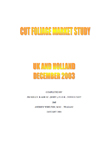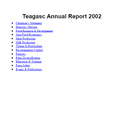
A short study of the operations of the principal participants in the UK and Dutch flower and foliage industry, commissioned by Bord Glas, was carried out in December 2003. The purpose of the study was to gain information on the general movement of foliage material within these two large markets and in particular to ascertain where the opportunities lie for current and aspiring foliage producers in Ireland.
- Date
- 1 January 2004
- Type
- Report

Situation and Outlook in Agriculture 2003/04
- Date
- 1 December 2003
- Type
- Report
National REPS Conference - REPS in a Changing Environment
- Date
- 4 November 2003
- Type
- Event Proceeding

The year 2002 was difficult for Irish and EU agriculture. The strengthening of the euro, the slowdown in international markets and the wet summer resulted in increased costs, difficult markets and lower margins.
- Date
- 1 October 2003
- Type
- Report
The purpose of this report is to assess marketing channels for conversion grade products as outlined in WP3 of the technical annex. The evaluation from the organic farmer and retailer perspective supplements the previous work package (WP2) that examined factors affecting conventional farmers considering conversion to organic farming.
- Date
- 1 August 2003
- Type
- Report
National Conference on Agricultural Education
- Date
- 18 February 2003
- Type
- Event Proceeding
To provide an independent and authoritative research knowledge base, technology transfer and training services for the sustainable development of agriculture and the food processing industry to enable it to respond profitably to consumer demands and requirements and contribute to a vibrant rural economy and society.
- Date
- 1 January 2003
- Type
- Factsheet
Cryptosporidium parvum is a parasite which has already causes significant public health problems in the water industry and is now emerging as a potential food contaminant. This parasite can be present in the intestinal tract of animals including cattle and sheep and can be excreted in stable form as an oocyst from infected hosts. The oocyst can then contaminate the environment and enter the water and/or food chain. The clinical symptoms of C. parvum infection include acute watery diarrhoea with abdominal pain, accompanied by vomiting and weight loss. The disease is usually self-limiting with a duration of 2-3 weeks, although it can last up to 6 weeks. However in immunocompromised people the illness can become chronic and persistent. There is no specific antibiotics or clinical treatment available for treatment of this infection. While predominantly considered a water borne contaminant, Cryptosporidium parvum has also been linked to a small number of food borne outbreaks involving raw goats milk, tripe, salad, raw milk, offal and sausage and apple cider. To date, the source of many C. parvum infections have never identified due to a lack of routine methods for the detection of this pathogen and there is sparse data available on the risk the parasite poses in foods.
- Date
- 1 January 2003
- Type
- Event Proceeding
